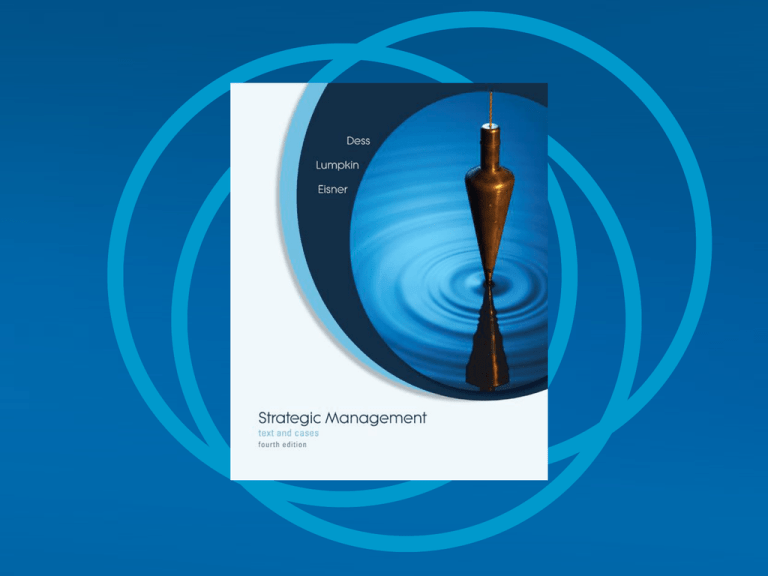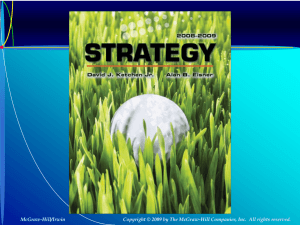
7
International Strategy:
Creating Value in
Global Markets
McGraw-Hill/Irwin
Strategic Management: Text and Cases, 4e
Copyright © 2008 The McGraw-Hill Companies, Inc. All rights reserved.
7-3
Learning Objectives
•
After reading this chapter, you should have a good
understanding of:
-
-
-
The importance of international expansion as a viable diversification
strategy.
The sources of national advantage, that is, why an industry in a given
country is more (or less) successful than the same industry in another
country.
The motivations (or benefits) and the risks associated with
international expansion, including the emerging trend for greater
offshoring and outsourcing activity.
The two opposing forces—cost reduction and adaptation to local
markets—that firms face when entering international markets.
7-4
Learning Objectives
•
After reading this chapter, you should have a good
understanding of:
-
-
The advantages and disadvantages associated with each of the four
basic strategies: international, global, multidomestic, and
transnational.
The difference between regional companies and truly global
companies.
The four basic types of entry strategies and the relative benefits and
risks associated with each of them.
7-5
The Global Economy: A Brief Overview
• Opportunities and risks when firms diversify abroad
- Trade across nations will exceed trade within nations
- Rise of market capitalism around the world
- Transfer of money from rich to poor countries
• Equity
• Bond Investments
• Commercial loans
7-6
The Global Economy: A Brief Overview
• Opportunities and risks when firms diversify abroad
- Economies of East Asia have grown rapidly, but little
progress in the rest of the world
- Poor education levels in many countries
- Failure to manage broader economic factors in some
countries
• Interest rates
• Inflation
• Unemployment
7-7
Factors Affecting
a Nation’s Competitiveness
• Factor conditions
- Nation’s position in factors of production
• Skilled labor
• Infrastructure
• Demand conditions
- Nature of home-market demand
• Industry’s product
• Industry’s service
7-8
Factors Affecting
a Nation’s Competitiveness
• Related and supporting industries
- Presence or absence in the nation of internationally
competitive
• Supplier industries
• Other related industries
• Firm strategy, structure, and rivalry
- Conditions in the nation governing how companies are
• Created
• Organized
• Managed
- Nature of domestic rivalry
7-9
Factor Conditions
• To achieve competitive advantage, factors of
production must be created
- Industry specific
- Firm specific
- Pool of resources at a firm’s or country’s disposal is less
important than the speed and efficiency with which the
resources are deployed
7 - 10
Demand Conditions
• Demands that consumers place on an industry for
goods and services
- Demanding consumers push firms to move ahead of
companies from other nations
- Demanding consumers drive firms in a country to
• Meet high standards
• Upgrade existing products and services
• Create innovative products and services
7 - 11
Example
• The demand for gasoline in the United States has not
fallen despite recent surges in gasoline prices.
• An increased supply has eased the price of gasoline for
consumers recently.
• There are still several risks that could affect the
demand conditions for gasoline
- The high price of Ethanol
- Volatility in the oil market
Source: Business Week, June 5, 2006
7 - 12
Related and Supporting Industries
• Related and supporting industries
- Enable firms to manage inputs more effectively
- Strong supplier base adds efficiency to downstream
activities
- Competitive supplier base lets a firm obtain inputs using
cost-effective, timely methods
- Allow joint efforts among firms
- Create the probability that new entrants will enter the
market
7 - 13
Firm Strategy, Structure and Rivalry
• Rivalry is intense in nations with conditions of
- Strong consumer demand
- Strong supplier bases
- High new entrant potential from related industries
• Competitive rivalry increases the efficiency with
which firms develop, market, and distribute products
and services within the home country
7 - 14
Firm Strategy, Structure and Rivalry
• Competitive rivalry increases the efficiency with
which firms
- Develop within the home country
- Market within the home country
- Distribute products and services within the home country
7 - 15
Firm Strategy, Structure and Rivalry
• Domestic rivalry provides a strong impetus for firms
to
- Innovate
- Find new sources of competitive advantage
• Domestic rivalry forces firms to look beyond national
borders for new markets
7 - 16
Question
Firms that succeeded in ______ had first succeeded in
intensely competitive ______.
A) home markets; global markets
B) global markets; home markets
C) national markets; global markets
D) international markets; national markets
7 - 17
Porter’s Diamond of National
Advantage: As Applied to India
Adapted from Exhibit 7.1 India’s Diamond in Software
7 - 18
A Company’s Motivation for
International Expansion
• Increase the size of potential markets
• Attain economies of scale
• Reducing the costs of R&D as well as operating costs
• Extend the life cycle of a product
• Optimize the physical location for every activity in its
value chain
- Performance enhancement
- Cost reduction
- Risk reduction
7 - 19
Potential Risks of
International Expansion
• Political and economic risk
-
Social unrest
Military turmoil
Demonstrations
Violent conflicts and terrorism
Laws and their enforcement
7 - 20
Example
• The 2006 Transparency International Corruption
Perceptions Index (CPI) reveals the most corrupt
countries in the world
• The scores range from ten (squeaky clean) to zero
(highly corrupt).
• The five most corrupt countries are
1.
2.
3.
4.
5.
Haiti (CPI Score: 1.8)
Myanmar (CPI Score: 1.9)
Iraq (CPI Score: 1.9)
Guinea (CPI Score: 1.9)
Sudan (CPI Score: 2.0)
Source: Transparency International, 2006, www.transparency.org
7 - 21
Risk Rankings
Exhibit 7.3 A Sample of International Country Risk Rankings
Source: Adapted from worldbank.org/html/prddr/trans/so96/art7.htm.
7 - 22
Potential Risks of
International Expansion
• Currency risks
- Currency exchange fluctuations
- Appreciation of the U.S. dollar
• Management risks
-
Culture
Customs
Language
Income levels
Customer preferences
Distribution system
7 - 23
Outsourcing and Offshoring
• Outsourcing occurs when a firm decides to utilize
other firms to perform value-creating activities that
were previously performed in-house.
• Offshoring takes place when a firm decides to shift an
activity that they were previously performing in a
domestic location to a foreign location.
7 - 24
Two Opposing Pressures: Reducing
Costs and Adapting to Local Markets
• Strategies that favor global products and brands
- Should standardize all of a firm’s products for all of their
worldwide markets
- Should reduce a firm’s overall costs by spreading
investments over a larger market
- Are based on three assumptions
• Customer needs and interests worldwide are becoming more
homogeneous
• People (worldwide) prefer lower prices at high quality
• Economies of scale in production and marketing can be
achieved through supplying global markets
7 - 25
Two Opposing Pressures: Reducing
Costs and Adapting to Local Markets
• But those three assumptions may not always be true
- Product markets vary widely between nations (customer
needs and interests?)
- In many product and service markets, there appears to be a
growing interest in multiple product features, quality and
service (preference for low price?)
- Technology permits flexible production, cost of production
may not be critical to product cost, and firm’s strategy
should not be product-driven
7 - 26
Opposing Pressures and Four Strategies
Exhibit 7.4 Opposing Pressures and Four Strategies
7 - 27
International Strategy
• Pressure for both local adaptation and low costs are
rather low
• Different activities in the value chain have different
optimal locations
• Susceptible to higher levels of currency and political
risks
7 - 28
Global Strategy
• Competitive strategy is centralized and controlled
largely by corporate office
• Emphasizes economies of scale
• Advantages
-
Larger production plants
Efficient logistics and distribution networks
Supports high levels of investment in R&D
Standard level of quality throughout the world
7 - 29
Global Strategy
• Disadvantages
- Concentration on scale-sensitive resources and activities in
one or few locations leads to higher transportation and tariff
costs
- Activity is isolated from targeted markets
- The rest of the firm becomes dependent on that
geographically isolated location
7 - 30
Multidomestic Strategy
• Emphasis is differentiating products and services to
adapt to local markets
• Authority is more decentralized
• Risks include
- Increased cost structure
- Potential problems with local adaptations
- Finding optimal degree of local adaptation is difficult
7 - 31
Transnational Strategy
• Optimization of tradeoffs associated with efficiency,
local adaptation, and learning
• Firm’s assets and capabilities are dispersed according
to the most beneficial location for a specific activity
• Avoids the tendency to either
- Concentrate activities in a central location
- Disperse them across many locations to enhance adaptation
7 - 32
Transnational Strategy
• Unique risks and challenges
- Choice of an “optimal” location cannot guarantee that the
quality and cost of factor inputs will be optimal
- Knowledge transfer can be a key source of competitive
advantage, but it does not take place automatically
7 - 33
Entry Modes of International Expansion
Adapted from Exhibit 7.10 Entry Modes for International Expansion
7 - 34
Question
Discuss the advantages and disadvantages of licensing
and franchising.



![Lecture 2a How to Th.. - of [www.mdavis.cox.smu.edu]](http://s3.studylib.net/store/data/008571683_1-b9817424524385f28bc5c351abe2212a-300x300.png)





